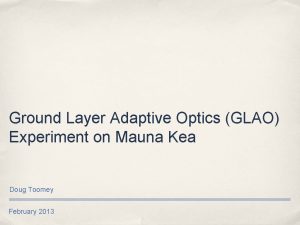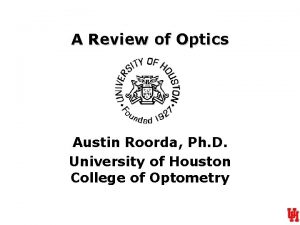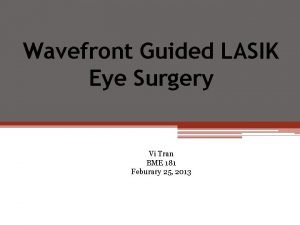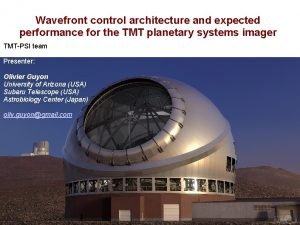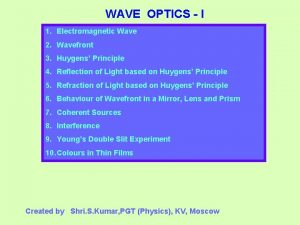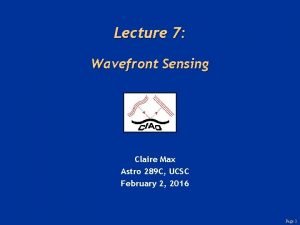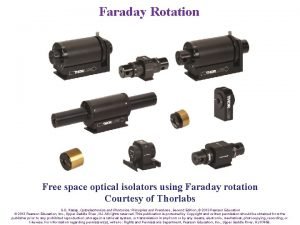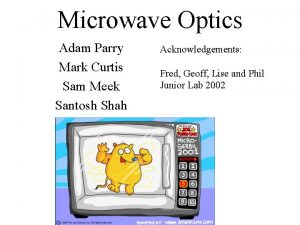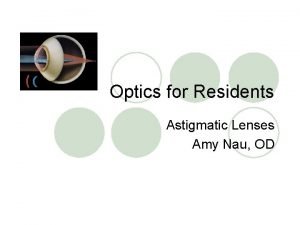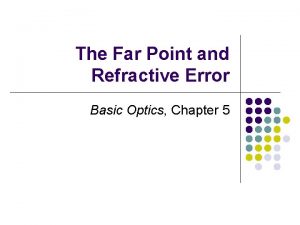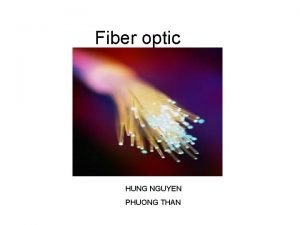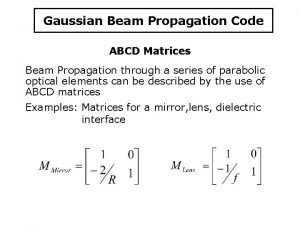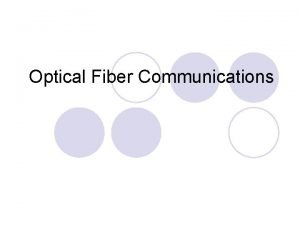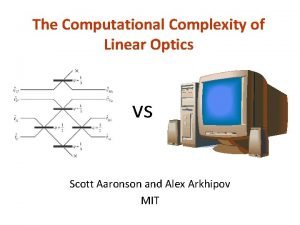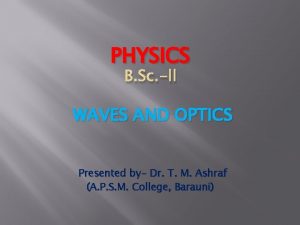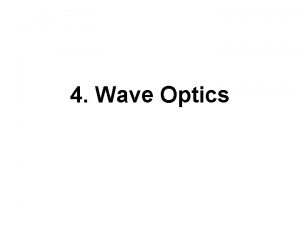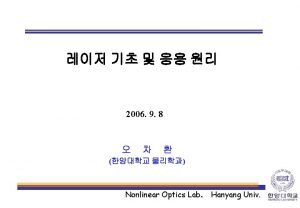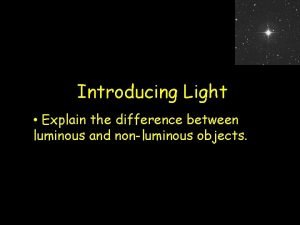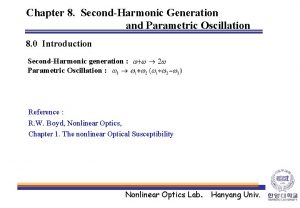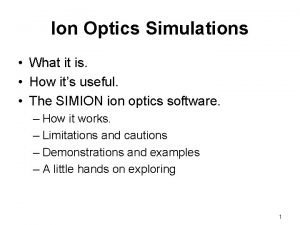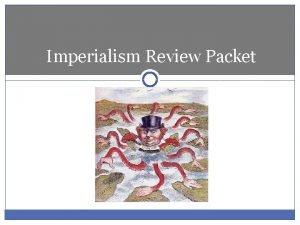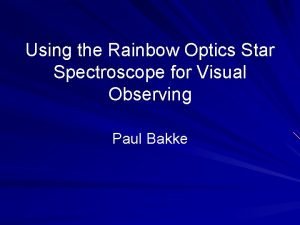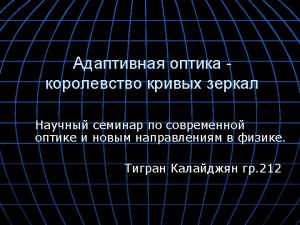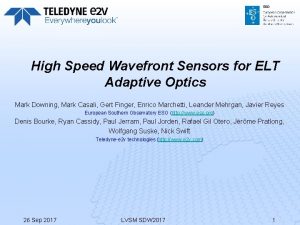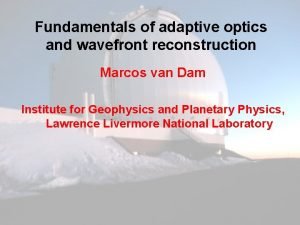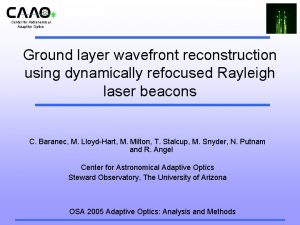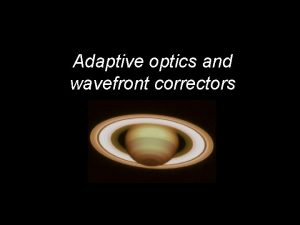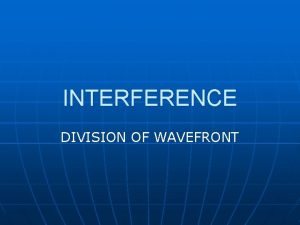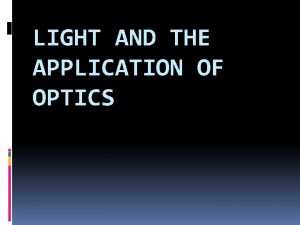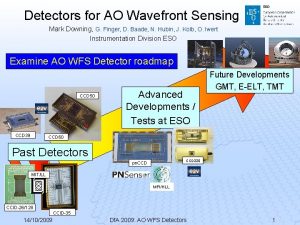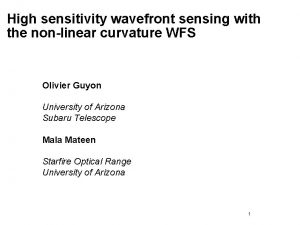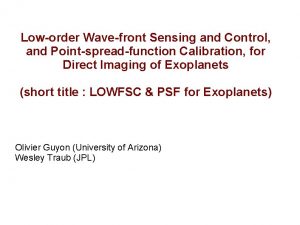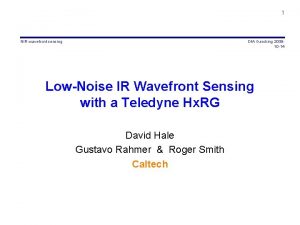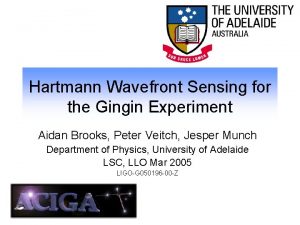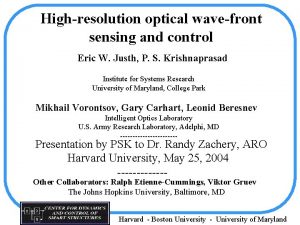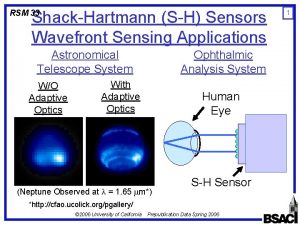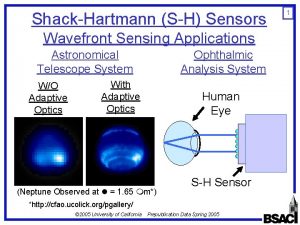Widefield wavefront sensing in Solar Adaptive Optics its


























- Slides: 26

Wide-field wavefront sensing in Solar Adaptive Optics its modeling and its effects on reconstruction Clémentine Béchet, Michel Tallon, Iciar Montilla, Maud Langlois Centre de Recherche Astrophysique de Lyon (CRAL) Instituto de Astrofisica de Canarias (IAC) May 2013, AO 4 ELT 3 (Florence, Italy)

Outline 1. Context: AO for the 4 -m diameter European Solar Telescope (EST) a) EST AO goals b) preliminary design 2. Wavefront sensing in solar AO a) reminder on solar AO wavefront sensing b) anisoplanatism in wide-field sensor data 3. A model for wide-field wavefront sensing a) for more realistic data simulation b) for reconstruction? 4. Conclusions & Future work

1. Context : AO for the 4 -m diameter European Solar Telescope (EST) § Collaboration with � Instituto Astrofisica de Canarias (I. Montilla) § Not a 30 -m class telescope, just a 4 -m one, but… – wide-field correction for high strehl at visible wavelengths – complexity close to TMT, GMT or E-ELT AO systems § construction 2019 -> 1 st light 2025 § EST AO goals : ambitious! – correction abilities over a wide range of elevations (down to 15 degrees) – requirements over a corrected fov of 1’ diameter: Ø Strehl (500 nm) > 30% for r 0 = 7 cm Ø Strehl (500 nm) > 50% for r 0 = 14 cm Ø Strehl (500 nm) > 60% for r 0 = 20 cm

1. Context : AO for the 4 -m diameter European Solar Telescope (EST) § EST AO system preliminary design – – – 5 DMs to cover a wide range of elevations 1 on-axis (10”x 10”) high-order Shack-Hartmann WFS 1 “over-the-field” (70”x 70”) low-order Shack-Hartmann WFS sensed fields of 10”x 10” for both SH-WFS 1. 5 -2 k. Hz frame-rate for cross-correlating sensed fields AO MCAO DMs heights 0 km 0, 2, 6, 10, 23 km DMs spacings 8 cm (~1800 act. ) 8, 30, 30 cm (~ 4000 act. ) sensing fields 1 (10”x 10”) 19 (10”x 10”) subap. size 8 cm (~1800 in total) 8 cm, 30 cm (128 subaps. in § designed from an budget error and Fourier code analysis total) (Berkefeld & Soltau, 2010) § … but requires end-to-end simulations

1. Context : AO for the 4 -m diameter European Solar Telescope (EST) § Why � end-to-end simulations? – lessons learned from E-ELT phase A studies, of huge difficulties to provide an exhaustive and clear error budget, error term by error term, for tomography – experienced limitation of Fourier codes Le Louarn et al. SPIE 2012 ATLAS/LTAO E 2 E simulations to determine the impact of LGS constellation radius on Strehl Octopus+FRi. M-3 D in closed-loop : E 2 E FRi. M-3 D reconstruction only: E 2 E Octopus+other reconstructor: E 2 E Fourier code from ONERA Octopus : ESO E 2 E AO simulator

1. Context : AO for the 4 -m diameter European Solar Telescope (EST) § Why � end-to-end simulations? – lessons learned from E-ELT phase A studies, of huge difficulties to provide an exhaustive and clear error budget, error term by error term, for tomography – experienced limitation of Fourier codes § need of a fast simulator for very large AO systems – Octopus (ESO end-to-end simulator for AO) Ø cluster of hundreds of slaves Ø diffractive model – FRi. M-3 D (CRAL developments) Ø sparse/fast modeling operators, Ø geometric models, Ø works even on an old laptop § started ESTAO E 2 E simulations (Montilla et al. SPIE 2012 and a poster this week) but needed new developments of FRi. M-3 D to adapt it to solar AO => focus of this talk: anisoplanatism in the AO wavefront sensing

2. Wavefront sensing in solar AO a) solar wavefront sensing in a nutshell – – – key approach = crosscorrelating SH-WFS fov of 5”x 5” minimum (von der Lühe, 1983) to track gradients on granulation more robust if fov larger than 8’’x 8’’ (VTT example, von der Lühe et al. , 2005)

2. Wavefront sensing in solar AO a) solar wavefront sensing in a nutshell – – – § § key approach = crosscorrelating SH-WFS fov of 5”x 5” minimum (von der Lühe, 1983) to track gradients on granulation more robust if fov larger than 8’’x 8’’ combination of high-order WFS and 19 sensed fields (~10”x 10”) in 70”x 70” loworder WFS but 10” is usually larger than the isoplanatic patch (500 nm) (VTT example, von der Lühe et al. , 2005)

2. Wavefront sensing in solar AO § small & usually negligible fov in night-time AO 3”x 3” 50 cm subap. b) Anisoplanatism effect on data

2. Wavefront sensing in solar AO § wide-field solar AO sensing 10”x 10” 10 cm subap. b) Anisoplanatism effect on data – cross-correlation over 10” fov = average gradient over the subap. and over the fov. – independent contribution of each layers – with increasing height, averaging over a wider layer area – loosing sensitivity of the onaxis wavefront distortions at high altitude

2. Wavefront sensing in solar AO § 4 m-diameter, 10 cm subaps. § reconstruction error only (noiseless) fitting b) Anisoplanatism effect on data – cross-correlation over 10” fov = average gradient over the subap. and over the fov. – independent contribution of each layers – with increasing height, averaging over a wider layer area – loosing sensitivity of the on-axis wavefront distortions at high height – same conditions as Marino 2012 (Haleakala profile, no

2. Wavefront sensing in solar AO § 4 m-diameter, 10 cm subaps. § reconstruction error only (noiseless) fitting b) Anisoplanatism effect on data – cross-correlation over 10’’ fov = average gradient over the subap. and over the fov. – independent contribution of each layers – with increasing height, averaging over a wider layer area – loosing sensitivity of the on We need to model the wide-field wavefront sensing in solar E 2 E axis wavefront distortions at simulations high height – same conditions as Marino 2012 (Haleakala profile, no strong layer in high altitude) simulated with FRi. M-3 D

3. A model for wide-field wavefront sensing a) for more realistic simulations by FRi. M-3 D – – ideally 0” new! – “small fov” model already from night-time AO based on continuous interpolation functions to model the turbulent layers “wide-field” solar model : includes the average over the fov F, introducing enough subdirections for sensing contribution per layer

3. A model for wide-field wavefront sensing a) for more realistic simulations by FRi. M-3 D § anisoplanatism contribution to data, per layer :

3. A model for wide-field wavefront sensing a) for more realistic simulations by FRi. M-3 D § anisoplanatism contribution to data, per layer : § for a complete profile, contribution of layers can be added in variance § for examples: – – – E-ELT profile (MAORY phase A) Cerror Pachon median profile Haleakala profile (Marino 2012) a) wfs fov = 8” x 8” b) r 0 = 15 cm c) zenith angle = 60 deg. ~ 40 nm rms

3. A model for wide-field wavefront sensing b) for the reconstruction? § FRi. M-3 D can use various fast models of SH sensing in its minimum-variance reconstruction algorithm

3. A model for wide-field wavefront sensing b) for the reconstruction? § FRi. M-3 D can use various fast models of SH sensing in its minimum-variance reconstruction algorithm “wide-fov” “small-fov” with nsubdir = 4 only 1 reconstructe d layer 10” several reconstructe d layers 10”

3. A model for wide-field wavefront sensing b) for the reconstruction? § FRi. M-3 D can use various fast models of SH sensing in its minimum-variance reconstruction algorithm “wide-fov” “small-fov” with nsubdir = 4 only 1 reconstructe d layer 10” several reconstructe d layers 10” is there a benefit in using S 4 in the 10”

3. A model for wide-field wavefront sensing b) for the reconstruction? § toy case #1 : 1 simulated layer only fitting

3. A model for wide-field wavefront sensing b) for the reconstruction? § toy case #1 : 1 simulated layer only fitting

3. A model for wide-field wavefront sensing b) for the reconstruction? § toy case #1 : 1 simulated layer only fitting probable benefit since S 4 allows to reconstruct layers in

3. A model for wide-field wavefront sensing b) for the reconstruction? § toy case #2 : 1 simulated layer only 2 reconstructed layers: at 0 km and another height h fitting

3. A model for wide-field wavefront sensing b) for the reconstruction? § toy case #2 : 1 simulated layer only 2 reconstructed layers: at 0 km and another height h ? ? ? fitting

3. A model for wide-field wavefront sensing b) for the reconstruction? § toy case #2 : 1 simulated layer only 2 reconstructed layers: at 0 km and another height h ? ? ? fitting benefit from S 4 fitting is strongly related to the priors!

3. A model for wide-field wavefront sensing b) for the reconstruction? § Complete atmosphere reconstruction (Haleakala profile, Marino 2012) at the end of the day, no quantitative benefit from S 4 in single-sensor reconstruction checked for various profiles, elevations, seeing, noise levels, … the average of the data over the field of view definitely degrade the possible performance

4. Conclusions & future work Ø challenging AO system for the future European solar telescope Ø simulations of the system started in collaboration between CRAL and IAC § to understand new issues of solar AO (e. g. anisoplanatism for SCAO) § to consolidate the error budget (anisoplanatism, 5 DMs, low-order sensing, high-order sensing) Ø simulator FRi. M-3 D, developed at CRAL, now allows to model the anisoplanatism in the wide-field data § anisoplanatism error can range from a few nm rms to 100 nm rms (for bad conditions) Ø the use of an approximated model with 4 subdirections in the reconstructor does not significantly reduces the drop of the SCAO Strehl due to the sensing anisoplanatism Ø anisoplanatism can now however be simulated in solar MCAO mode (on-going EST and Big Bear simulations with FRi. M-3 D), and we will Posters: I. Montilla et al. (ESTAO), M. Langlois et al. (Big Bear) evaluate how much it could be canceled by the tomographic correction
 Difference between ray optics and wave optics
Difference between ray optics and wave optics Reflection and refraction venn diagram
Reflection and refraction venn diagram Adaptive optics
Adaptive optics Austin roorda
Austin roorda Wavefront
Wavefront Wavefront architecture
Wavefront architecture Em wave2
Em wave2 Shack hartmann wavefront sensor tutorial
Shack hartmann wavefront sensor tutorial Wavefront
Wavefront Wholesalesolar.com/solar panels
Wholesalesolar.com/solar panels Solar energy is free. solar is inexhaustible
Solar energy is free. solar is inexhaustible Nonlinear optics
Nonlinear optics Sam meek
Sam meek Maddox rod
Maddox rod Far point optics
Far point optics Dr hung nguyen
Dr hung nguyen Abcd matrix example
Abcd matrix example Losses in optical fiber
Losses in optical fiber The computational complexity of linear optics
The computational complexity of linear optics Wave optics b.sc physics
Wave optics b.sc physics Fourier optics
Fourier optics Nonlinear optics
Nonlinear optics Luminous and non luminous objects worksheet
Luminous and non luminous objects worksheet Purtubation
Purtubation Ion optics simulation
Ion optics simulation Optics
Optics Rainbow optics star spectroscope
Rainbow optics star spectroscope


